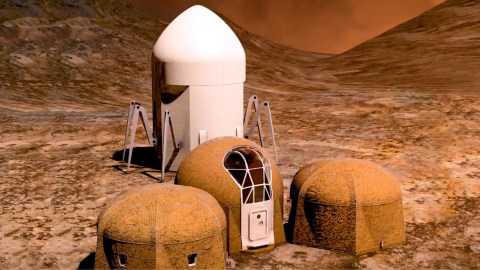NASA reveals the latest winning ideas for buildings on Mars

Living on Mars is a dream long-held by science fiction writers and many would-be space explorers. Of course, we have to get there first. NASA’s plans remain robotic for now, with new rovers (and a Mars Helicopter) starting in 2020. The White House has asked NASA to return to the moon in order to, among other things, develop a launch facility for a human Mars mission. NASA’s own suspicion is that we’ll eventually travel to Mars aboard their Space Launch System rocket platform. Yet, assuming we do someday send people to populate the red planet, what kind of Mars-friendly structures will they need?
NASA has been looking for an answer to this question and has been running, along with Bradley University and other partners, a three-stage, multimillion-dollar 3D-Printed Habitat Competition to find it. The space agency has just announced five winning teams for the third stage’sfirst construction level in which they designed innovative Mars habitats and created virtual models of the structures.
The winners will share the level’s $100,000 prize:
- Team Zopherus of Rogers, Arkansas — $20,957.95
- AI. SpaceFactory of New York — $20,957.24
- Kahn-Yates of Jackson, Mississippi — $20,622.74
- SEArch+/Apis Cor of New York — $19,580.97
- Northwestern University of Evanston, Illinois — $17,881.10
Creativity, architectural know-how, and a grasp of the Martian environment are required to meet a Mars mission’s unique challenges. For one thing, the planet is inhospitable — extremely hot and cold, for example — and completely lacks any supporting infrastructure for the buildings, so they need to be hardy and self-sufficient. In addition, getting traditional building materials all the way to Mars is impractical at best and maybe impossible — this is why NASA is betting on 3D-printing as the most practical means of fabricating Martian structures.
First Place: Team Zopherus

2nd Place: AI. SpaceFactory

3rd Place: Kahn-Yates

4th Place: SEArch+/Apis Cor

5th Place: Northwestern University

Planning ahead
Who knows when humans will actually get to Mars. Maybe by then, we’ll simply be able to replicate our structures a la Star Trek. Still, it’s not unlikely that all this advance planning and thinking will ultimately illuminate the underlying architectural solutions that will be required for life on the red planet. Meanwhile, we can use our imaginations to picture what living in each of these dazzling structure might be like after a hard day in the searing Martian sun, or during a bone-chilling red-planet night.





